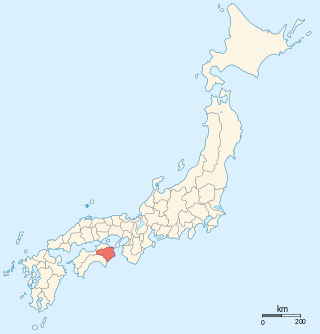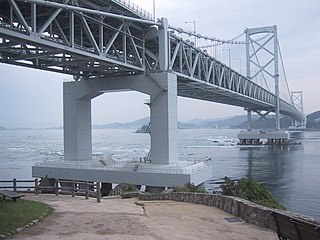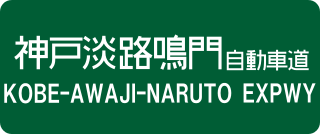Naruto is a Japanese manga which consists of an anime adaptation and video games.
Contents
Naruto or Narutō may also refer to:
- Naruto Uzumaki, the protagonist of the franchise
Naruto is a Japanese manga which consists of an anime adaptation and video games.
Naruto or Narutō may also refer to:

Tokushima Prefecture is a prefecture of Japan located on the island of Shikoku. Tokushima Prefecture has a population of 728,633 and has a geographic area of 4,146 km2. Tokushima Prefecture borders Kagawa Prefecture to the north, Ehime Prefecture to the west, and Kōchi Prefecture to the southwest.

Naruto is a city located in Tokushima Prefecture, Japan. As of 30 June 2022, the city had an estimated population of 54,989 in 26,206 households and a population density of 410 persons per km². The total area of the city is 191.11 square kilometres (73.79 sq mi).

The Seto Inland Sea, sometimes shortened to the Inland Sea, is the body of water separating Honshu, Shikoku, and Kyushu, three of the four main islands of Japan. It serves as a waterway connecting the Pacific Ocean to the Sea of Japan. It connects to Osaka Bay and provides a sea transport link to industrial centers in the Kansai region, including Osaka and Kobe. Before the construction of the San'yō Main Line, it was the main transportation link between Kansai and Kyūshū.

Awaji Island is an island in Hyōgo Prefecture, Japan, in the eastern part of the Seto Inland Sea between the islands of Honshū and Shikoku. The island has an area of 592.17 square kilometres. It is the largest island of the Seto Inland Sea.

Awa Province was a province of Japan in the area that is today Tokushima Prefecture on the island of Shikoku. Awa was bordered by Tosa, Sanuki, and Iyo Provinces. Its abbreviated form name was Ashū (阿州). In terms of the Gokishichidō system, Awa was one of the provinces of the Nankaidō circuit. Under the Engishiki classification system, Awa was ranked as one of the 35 "superior countries" (上国) in terms of importance, and one of the "middle countries" (中国) in terms of distance from the capital. The provincial capital was located in what is now the city of Tokushima.

The Honshu-Shikoku Bridge Project is a system of bridges connecting the islands of Honshu and Shikoku across the Inland Sea of Japan, which were previously only connected by ferry. It consists of three major connections. All bridges are now controlled by the Honshu-Shikoku Bridge Expressway Company and the Japan Expressway Holding and Debt Repayment Agency (日本高速道路保有・債務返済機構). The system consists of three expressways and their respective bridge systems.

The Naruto whirlpools are tidal whirlpools in the Naruto Strait, a channel between Naruto in Tokushima and Awaji Island in Hyōgo, Japan. The strait between Naruto and Awaji island has a width of about 1.3 km. The strait is one of the connections between the Pacific Ocean and the Inland Sea, a body of water separating Honshū and Shikoku, two of the main islands of Japan. The tide moves large amounts of water into and out of the Inland Sea twice a day. With a range of up to 1.7 m (5.6 ft), the tide creates a difference in the water level of up to 1.5 m between the Inland Sea and the Pacific. Due to the narrowness of the strait, the water rushes through the Naruto channel at a speed of about 13–15 km/h (8–9 mph) four times a day, twice flowing in and twice flowing out. During a spring tide, the speed of the water may reach 20 km/h (12 mph), creating vortices up to 20 m (66 ft) in diameter.

Tokushima Vortis is a Japanese professional football club located in Tokushima, capital of Tokushima Prefecture. The club currently playing in the J2 League, the Japanese second tier of professional football league.

Minamiawaji is a city in the southern part of Awaji Island in Hyōgo Prefecture, Japan. As of 1 June 2022, the city had an estimated population of 45,489 in 19856 households, and a population density of 200 persons per km².The total area of the city is 229.01 square kilometres (88.42 sq mi).

The Kii Channel, also called the Kii Strait, is a strait separating the Japanese island of Shikoku from the Kii Peninsula on the main island of Honshū. This strait connects the Inland Sea with the Pacific Ocean.

The Ōnaruto Bridge is a suspension bridge on the Kobe-Awaji-Naruto Expressway connecting Minamiawaji, Hyogo on Awaji Island with Naruto, Tokushima on Ōge Island, Japan. Completed in 1985, it has a main span of 876 metres (2,874 ft). Although it is one of the largest bridges in the world, it is dwarfed by the Akashi-Kaikyo Bridge, which is on the same route. In 2004, 6.8 million cars and trucks crossed this bridge, translating into a daily average of about 18,600.

Setonaikai National Park is a Japanese national park, comprising areas of Japan's Seto Inland Sea, and of ten bordering prefectures. Designated a national park in 1934, it has since been expanded several times. It contains about 3,000 islands, known as the Setouchi Islands, including the well-known Itsukushima. As the park encompasses many non-contiguous areas, and covers a tiny proportion of the Inland Sea's total extent, control and protection is problematic; much of the wider area is heavily industrialized.

Sako Station is a junction passenger railway station located in the city of Tokushima, Tokushima Prefecture, Japan. It is operated by JR Shikoku and has two station numbers: "B01" for the Tokushima Line and "T01" for the Kōtoku Line.

The Tanagawa Line is a railway line in Osaka Prefecture, Japan, owned by Nankai Electric Railway. This line connects to the Nankai Main Line.

Japan Median Tectonic Line, also Median Tectonic Line (MTL), is Japan's longest fault system. The MTL begins near Ibaraki Prefecture, where it connects with the Itoigawa-Shizuoka Tectonic Line (ISTL) and the Fossa Magna. It runs parallel to Japan's volcanic arc, passing through central Honshū to near Nagoya, through Mikawa Bay, then through the Inland Sea from the Kii Channel and Naruto Strait to Shikoku along the Sadamisaki Peninsula and the Bungo Channel and Hōyo Strait to Kyūshū.

The Naruto Line is a railway line in Japan operated by Shikoku Railway Company. It connects Ikenotani Station and Naruto Station in Naruto, Tokushima.

Narutomaki (鳴門巻き/なると巻き) or naruto (ナルト/なると) is a type of kamaboko, or cured fish surimi produced in Japan. Each cloud-shaped slice of naruto has a pink or red spiral pattern, which is meant to resemble the Naruto whirlpools in the Naruto Strait between Awaji Island and Naruto, Tokushima Prefecture on Shikoku Island in Japan. The word is also used as a slang term for the at sign "@".

The Kobe-Awaji-Naruto Expressway is a tolled expressway that connects Hyōgo and Tokushima prefectures in Japan by crossings of the Akashi Strait and Naruto Strait. Built between 1970 and 1998, it is one of the three routes of the Honshu-Shikoku Bridge Expressway Company connecting Honshū and Shikoku islands. The route is signed E28 under Ministry of Land, Infrastructure, Transport and Tourism's "2016 Proposal for Realization of Expressway Numbering."

Ōge-jima (大毛島) is an island in the Seto Inland Sea administered under Naruto in Tokushima Prefecture.